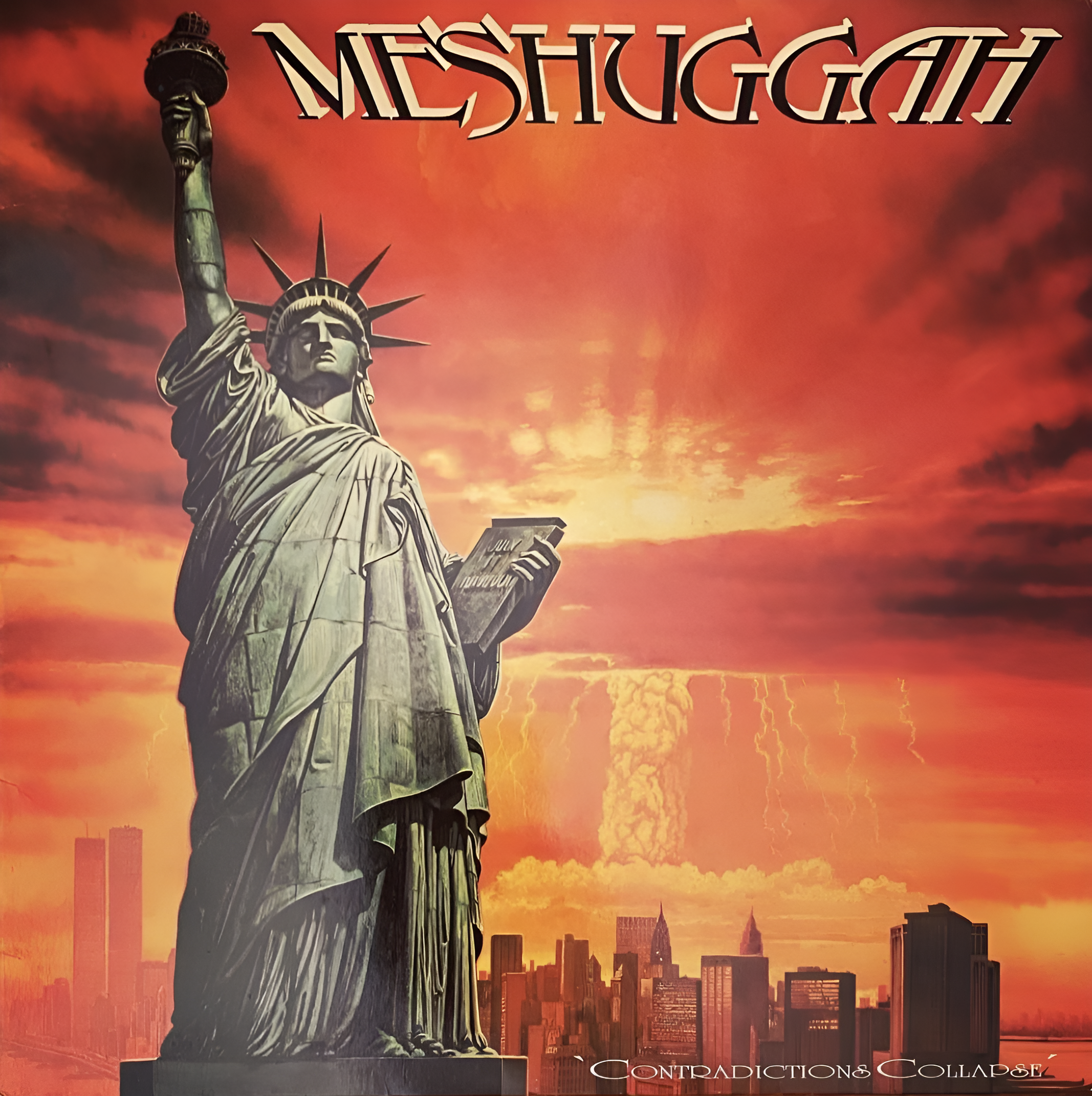
Released in May 1991, Contradictions Collapse marks Meshuggah’s official studio debut—a raw, complex, and deeply cerebral album that set the groundwork for one of metal’s most visionary legacies. Long before the band became synonymous with polyrhythms and 8-string guitars, Contradictions Collapse showcased a young Meshuggah already straining against convention, fusing thrash aggression, progressive structure, and mechanical precision into something that sounded like the future calling from inside the past.
Where later albums would embrace bleak minimalism and ultra-technical groove, Contradictions Collapse is all nerve and synapse—a full-body jolt of ideas, riffs, and intellectual rage. It’s less a refined blueprint than it is the explosive result of fusing several blueprints into one.
Industrial Thought, Human Fury: Blueprint of a New Metal Logic
From the opening salvo of “Paralyzing Ignorance,” it’s clear Meshuggah wasn’t interested in playing it safe. The track erupts with jagged thrash riffs and sudden rhythmic shifts that pull the listener into a sound that’s both familiar and alien. Jens Kidman’s vocals—shouted, snarled, and defiant—cut through the chaos like a transmission from a post-industrial war zone. But beneath the fury, there's a cerebral core: a frustration not just with society, but with the systems that shape it.
Songs like “Erroneous Manipulation” and “Qualms of Reality” push past standard song structures, favoring long, dissonant explorations that blend Metallica-style riffing with jazz-inflected time changes and bleak philosophical undertones. You can hear the gears of the machine turning—but it’s a machine built by people who are aware they’re trapped inside it.
At times, the album feels less like a metal record and more like a mathematical equation performed through distortion. The intensity doesn’t just come from volume—it comes from calculation. Meshuggah was already bending time and space before most of the metal world even realized it was possible.
Youth, Grit, and Vision: The Birth of Meshuggah’s Identity
Even in their earliest form, Meshuggah displayed a desire to deconstruct genre norms. Contradictions Collapse is undeniably heavy, but it’s not satisfied with being heavy in traditional ways. Guitarists Fredrik Thordendal and Mårten Hagström (though Hagström wouldn't officially join until later live performances) were already experimenting with rhythmic displacement and percussive riff phrasing that would become hallmarks of the band’s sound.
Thordendal’s leads—particularly on “Abnegating Cecity” and “Internal Evidence”—veer off into abstract, Allan Holdsworth-inspired territory. They don't shred for the sake of ego but feel like coded messages breaking through the static. The solos often feel like controlled implosions, not grandstanding.
Drummer Tomas Haake, even at this early stage, shows glimpses of the rhythmic architect he would become. His performance here is less overtly polyrhythmic than on later albums, but the building blocks are present—tight syncopation, jazz-influenced fills, and an uncanny ability to make the listener question where the “1” is.
Steel, Thought, and Revolution
The second half of the album turns darker and more experimental. “The Feeding Hand” is a sprawling, oppressive track that crawls through dissonant landscapes and bludgeoning grooves. It’s a perfect example of the band’s emerging desire to create mood as much as motion. The tempo slows, but the pressure mounts.
“Cadaverous Mastication” (originally part of their 1989 EP) makes its appearance as a blistering, angular closer. It’s here that Meshuggah’s future truly peeks through—an almost freeform structure, shifting tempos, and a sense that the song is consuming itself as it goes. There's a rawness that speaks of a band still carving its identity, but the vision is undeniable.
Thematically, Contradictions Collapse deals with inner conflict, social decay, and humanity’s self-made traps. There’s no fantasy here—just the grinding weight of reality analyzed through a cold, mechanized lens. But rather than succumbing to nihilism, Meshuggah channels it into purpose.
The Sound of Systems Breaking
Though produced on a relatively modest budget, Contradictions Collapse still holds up sonically—especially when viewed in historical context. The mix, raw and gritty, allows every instrument to retain its character. The guitars are sharp and percussive, the bass is audible and thick, and the drums punch through without sounding overly processed.
There’s no gloss here—just intent. The production reflects the content: stripped of illusion, honest in its imperfections, and relentlessly forward-thinking.
The album’s cover—a stark, surreal image of industrial chaos—perfectly mirrors the music. Cold steel meets fractured humanity. It's not just imagery—it’s prophecy.
Final Verdict: 8.5/10
With Contradictions Collapse, Meshuggah didn’t just announce their arrival—they challenged the very foundation of what metal could be. It’s not their most polished or accessible album, but it may be their most revealing. Every future innovation—every metric twist, every robotic groove, every philosophical unraveling—has its seed planted here.
This is where the journey begins. It’s the sound of ideas evolving at high speed, of creativity bursting at the seams. While later albums would refine the Meshuggah formula, Contradictions Collapse reminds us that sometimes, revolution starts not with precision—but with friction.
Standout Tracks:
- Paralyzing Ignorance
- Qualms of Reality
- Internal Evidence
- The Feeding Hand
- Cadaverous Mastication
Contradictions Collapse may not be the Meshuggah album you listen to the most—but it’s the one that made everything else possible. It doesn’t just ask questions—it dares you to dismantle the answers.
Until next time, play it loud, friends!

